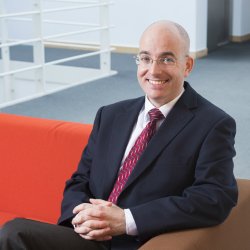Dr. David Birch speaks about his start-up Surrey Sensors
Head of Centre for Aerodynamics and Environmental Flow
Surrey Sensors

Dr. David Birch is an experimental aerodynamicist, and head of the Centre for Aerodynamics and Environmental Flow. In 2015, the start-up company Surrey Sensors Ltd. was formed in order to commercialise the measurement technology that was being developed as part of his wind-tunnel research into complex rotating flows. Now, the systems he and his team have developed are being exported around the world.
Innovation and technology transfer
The core innovation made by Dr. Birch and his team was the repurposing of low-cost, mass-market semiconductor sensor technologies for some very highly-specialised applications. Together with the very latest in miniature electronics and advanced signal processing techniques, this allowed them to produce world-leading measurement tools for a fraction of the cost of competing systems.
The accessibility and low cost of these instruments have opened up new markets in the aerospace, automotive, marine and medical sectors. The extremely small size of some of the systems has also resulted in a range of new opportunities in UAV avionics - one of the largest growth areas for Surrey Sensors Ltd.
"The facilities we have here at the university are unique", says Dr. Birch; "we host the National Atmospheric Measurement and Observation Facility for atmospheric boundary layer simulation, and we are separately developing some very compact, high-power electric fans for simulating jet engines in wind tunnels. These are incredibly challenging environments in which to make measurements, so we have always been forced to innovate."
Forming a tech start-up
"We have been incredibly lucky," says Dr. Birch. "Paul Nathan and I had just been quietly producing this technology out of necessity for ourselves and our colleagues, when quite by accident a small group of business managers and investors took notice." Dr. Paul Nathan was the instrumentation officer working in the Centre for Aerodynamics and Environmental Flow before he left to take up a full-time post as Technology Director at Surrey Sensors Ltd.
"With world-leading technologies, experienced business managers and clear strategy, the company has thrived and has been operating in profit since its first year. We've expanded our premises and staff, invested in new technology and will be introducing some very exciting new product lines."
"We're now seeing a self-sustaining cycle of research and technology transfer taking shape: the revenues generated by sales are being reinvested in the fundamental research programmes at the university, which are in turn leading to the next generation of technologies and products."
Crossing the Valley of Death
Many technologies are unable to cross the so-called "valley of death" between demonstration prototype and commercialisation. How did Surrey Sensors Ltd. accomplish this?
"A combination of factors," answers Dr. Birch. "First, as I said we were very lucky. We also had the right people in place: as a scientist and engineer, I am probably the best person to run a technology development programme but certainly not the best person to run a business. Support from the university's Technology Transfer Office has also been critical here- both in helping to assemble the team, and providing access to both IP and expertise."
